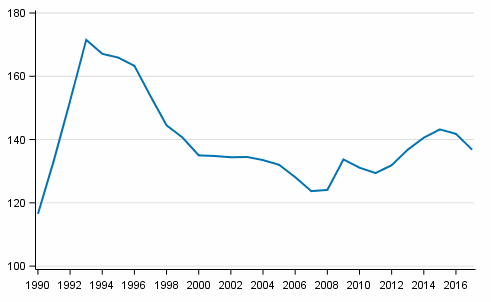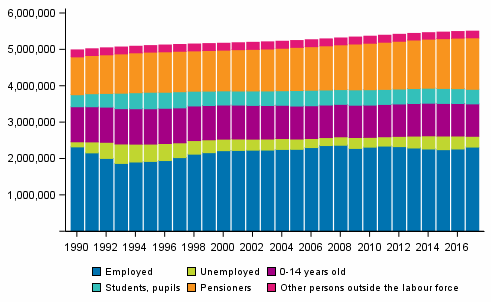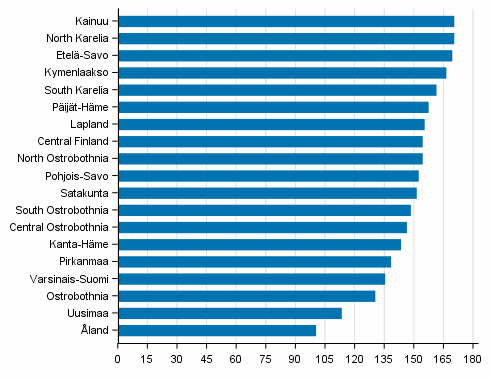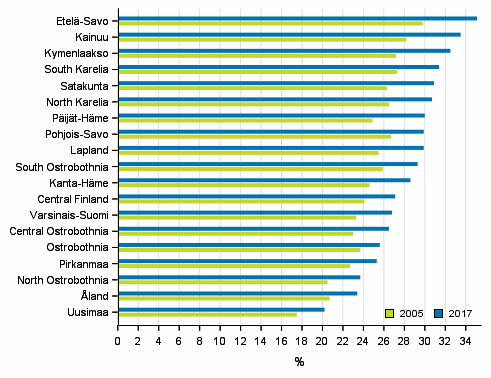1. Economic dependency ratio was 137 in 2017
According to the data of Statistics Finland's employment statistics, the economic dependency ratio was 137 in 2017. This means that there were 137 non-employed persons per one hundred employed persons in 2017. In 2016, the dependency ratio was 142. In total, there were 2,302,000 employed persons aged 18 to 64 in 2017 of which 2,074,000 were wage and salary earners and 228,000 self-employed persons. There were 296,000 unemployed persons and 2,889,000 persons in the inactive population.
Economic dependency ratio in 1990 to 2017

The economic dependency ratio refers to the ratio of the number of employed persons to unemployed persons and persons in the inactive population. The inactive population includes persons aged 0 to 14, students and pupils, conscripts and those in non-military service, pensioners and others in the inactive population.
When the number of employed rises relative to the number of unemployed and persons in the inactive population, the economic dependency ratio falls. Correspondingly, when the number of unemployed and persons in the inactive population grows relative to the number of employed, the economic dependency ratio grows. The variation of the economic dependency ratio may be influenced by the growing number of pensioners and the employment situation. There has been great variation in the economic dependency ratio in the past few decades. During the recession in the 1990s, the economic dependency ratio was high. It was at its highest in 1993, when there were 172 non-employed persons per one hundred employed persons. The economic dependency ratio was at its lowest in 1989 (112).
1.1 Number of employed in the population was 2,328,000 and that of persons in the inactive population was 3,185,000
In 2017, a total of 296,000 persons were unemployed. The number of unemployed fell by 60,000 from the year before. Of those in the inactive population, 1,415,000 were pensioners, 401,000 students and pupils, 890,000 were aged 0 to 14, and 7,700 were conscripts and in the non-military service.
According to the employment statistics, the share of unemployed persons aged 18 to 64 in the labour force was 11.4 per cent in 2017. From the previous year, the share fell by 2.2 percentage points. The share of unemployed was 10.3 per cent for women and 12.5 per cent for men. The unemployment rate describes the percentage of the unemployed in the labour force, i.e. employed and unemployed persons in total.
Population by main type of activity in 1990 to 2017

The weakening of the economic dependency ratio is influenced by the share of unemployed persons as well as by the ageing of the population and thus, by the number of pensioners. In 2017, Finland had 1,415,000 pensioners. In 2016, the number of pensioners was 1,390,000. The number of pensioners grew by 25,000 persons in a year.
1.2 Economic dependency ratios lowest in the regions of Ahvenanmaa, Uusimaa and Ostrobothnia
In the comparison between regions, the economic dependency ratio was lowest in Åland in 2017. In the region, there were 100 unemployed and persons in the inactive population per one hundred employed persons. In Åland, there were 14,700 employed and 570 unemployed persons. On the regional level, the economic dependency ratio was also low in the region of Uusimaa, where the economic dependency ratio was 113 and in Ostrobothnia, where it was 130. The economic dependency ratios in 2017 were highest in the following regions: Kainuu (170), North Karelia (170) Etelä-Savo (169). In Kainuu, there were 27,300 employed and 4,700 unemployed persons. In 2017, the share of unemployed in the labour force was highest in North Karelia (16.2%) and lowest in Åland (3.8%).
Economic dependency ratio by region in 2017

1.3 Share of pensioners largest in the region of Etelä-Savo
The growing number of pensioners is visible in all regions. There is great variation in the share of pensioners between the regions. In 2017, the share of pensioners in the population of the region was highest in the region of Etelä-Savo (35%) and lowest in the region of Uusimaa (20.1%). The number of pensioners was 52,000 in Etelä-Savo and 332,000 in Uusimaa in 2017.
Share of pensioners by region in 2005 and 2017

Source: Employment Statistics, Statistics Finland
Inquiries: Juhana Nordberg 029 551 3051, info@stat.fi
Director in charge: Jari Tarkoma
Updated 12.2.2019
Official Statistics of Finland (OSF):
Employment [e-publication].
ISSN=2323-6825. profession and socio economic position 2017,
1. Economic dependency ratio was 137 in 2017
. Helsinki: Statistics Finland [referred: 18.7.2024].
Access method: http://www.stat.fi/til/tyokay/2017/01/tyokay_2017_01_2019-02-12_kat_001_en.html

